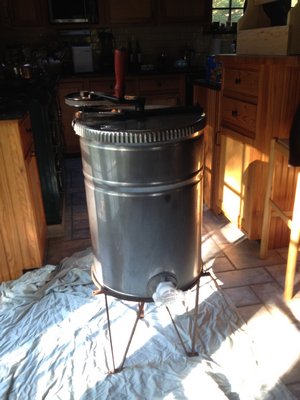
If we ever get to the point where we have enough honey to actually sell some, I’ll label it Lazarus Honey, because it will be purely miraculous; honey from beehives that have been raised from the dead. More than once.If you’ve been following this column, you know that our girls have suffered through enough indignities for a honeybee version of the Book of Job: small hive beetles, carpenter ants, robber bees, endless freezing winters and ridiculous quantities of beekeeper incompetence.
But as summer wound down this year, we dared to believe that we might, finally, harvest some honey from our one strong hive. The signs were all propitious. Spring got a delayed start, but since the weather warmed up, things have been blooming pretty much nonstop. The girls feasted on snowdrops and crocuses back in April; buzzed through roses, cosmos and tiger lilies through the summer; and are snacking away on raspberry flowers and blue salvia this afternoon.
We checked their progress in mid-July and they had one deep box full of honey and another medium-sized box started. We put a queen excluder—a sheet of perforated metal with spaces big enough for worker bees, but too small for the queen to fit through—between the deep and the medium to keep the queen from laying eggs in the honey frames, closed everything back up and left them alone to do their thing.
Deciding when and how much honey to take is something of a crap shoot. Bees don’t make honey because they love us and want to give us presents. They make honey to feed themselves and their young. Over thousands of years of beekeeping, humans have selectively bred honeybees that make and store more honey than they need. So, in theory, we can take some and they will still have enough to get through the winter.
In reality, the amount of honey one beehive produces depends on many variables, including weather, swarms, availability of good foraging plants, and the quality of the queen. Over the course of her six-week life, the average worker bee produces one-eighth of a teaspoon of honey. With a good queen laying 2,000 eggs a day, the hive churns out 14,000 worker bees a week. Those bees will cumulatively produce just over 9 quarts of honey before they keel over from exhaustion.
In our area, foraging begins with the first snowdrop blooms and ends when the last Montauk daisy gets zapped by frost in late autumn. We are blessed with a long growing season, so a hive in a good location can produce lots of honey.
Or not. As we’ve seen, when things are going really well early in the season, honeybees are likely to exercise their belief in manifest destiny and split, with half the hive swarming off to start a new hive. And instead of 80,000 worker bees, you’ve got 40,000 hustling for nectar, cutting production in half.
Or we may get a solid week of rain, keeping the bees hive-bound, eating up their stores instead of bringing in new groceries.
And then there’s the impending winter. Are we going into a deep freeze in December and staying there until April, like we did last winter? Or will it be nice and mild, with flowers blooming late and starting early?
Big commercial beekeepers take a lot of honey, then feed their bees sugar water to get them through the winter. It’s an effective strategy if your only goal is to get the maximum amount of honey from your hives. But if your goal is a thriving hive that gets through the winter and comes out strong in the spring, sugar water is no alternative to the complex blend of nutrients found in the bees’ own honey and pollen. In fact, it’s thought that the practice of feeding sugar plays a role in the huge numbers of bee colony deaths that occur every year.
All that said, we figured that with a full deep box, the girls would have about 60 pounds of honey, plus another 20 pounds or so in the brood (nursery) box. Should be enough, unless any one of a million possible things happens and it isn’t. We’ll probably feed them some sugar water before the weather gets too cold, to hedge our bets if we miscalculated.
Most of the beekeepers I know supplement their hives with sugar water, just in case. It’s no substitute for real honey, but it beats finding your bees dead in the spring because they didn’t quite have enough food to make it through to those first flowers. Because no matter how careful you are to leave enough honey, sometimes stuff happens.
But enough gloom and doom—we had honey to harvest!
Our girls are about as gentle as bees come, but no honeybee takes kindly to having her hard-won provisions stolen. Patrick made up a lidded box we could move the honey-filled frames into once we brushed the bees off of them, and it worked great. We suited up in our full haz-mat ensembles, and swapped out five full frames of honey for five empty frames they could fill back up. The whole thing took about 15 minutes, and I was delighted—until the guilt set in.
Once the bees realized the honey was gone, they became frantic, flying all over the yard looking for their property. I felt terrible. Until dark that night, they scoured every corner of the yard in what sure looked to me like a panic. And they still weren’t aggressive toward us at all, which only made me feel worse about our traitorous thievery.
Our total take this year was about a gallon and a half of honey. I don’t think Lazarus Honey poses a threat to Sue Bee Honey just yet, but it’s a start. And guilt aside, there is nothing like the taste of homegrown honey in January to remind you that spring will eventually come again.